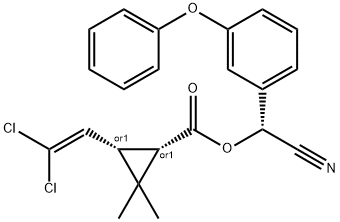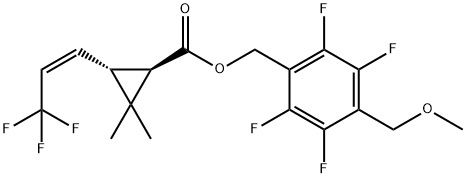alpha-Cypermethrin
Synonym(s):α-metherin;Alphamethrin
- CAS NO.:67375-30-8
- Empirical Formula: C22H19Cl2NO3
- Molecular Weight: 416.3
- MDL number: MFCD01735713
- EINECS: 614-054-3
- SAFETY DATA SHEET (SDS)
- Update Date: 2024-12-18 14:07:02

What is alpha-Cypermethrin ?
Chemical properties
alpha-cypermethrin is a colorless crystalline solid or viscous yellowish-brown semisolid mass. mild aromatic odor. easily soluble in alcohols, ketones and aromatic hydrocarbon organic solvents, such as cyclohexanone 515g/l, xylene 315g/l, solubility in water 5 ~ 10mg/l (0.01 ~ 0.2mg/l). it is relatively stable under acidic and neutral conditions, easy to hydrolyze under strong alkaline conditions, and has good thermal stability.
The Uses of alpha-Cypermethrin
alpha-Cypermethrin is a synthetic pyrethroid pesticide used in large-scale commercial agricultural applications as well as in consumer products for domestic purposes.
The Uses of alpha-Cypermethrin
insecticide
The Uses of alpha-Cypermethrin
Alpha-cypermethrin is used to control a wide range of insects, especially Lepidoptera, in fruit, vines, vegetables, cereals, beans, beets, cotton, ornamentals and forestry and other crops. It is also used for insect control in public health and for ectoparasite control on animals.
Definition
ChEBI: Cypermethrin is a carboxylic ester resulting from the formal condensation between 3-(2,2-dichlorovinyl)-2,2-dimethylcyclopropanecarboxylic acid and the alcoholic hydroxy group of hydroxy(3-phenoxyphenyl)acetonitrile. It has a role as a pyrethroid ester insecticide, a pyrethroid ester acaricide, an agrochemical and a molluscicide. It is an organochlorine compound, a nitrile, an aromatic ether and a cyclopropanecarboxylate ester. It is functionally related to a 3-(2,2-dichlorovinyl)-2,2-dimethylcyclopropanecarboxylic acid.
Agricultural Uses
Insecticide: A U.S. EPA restricted Use Pesticide (RUP) (zeta-Cypermethrin only). Used for the control of a wide range of chewing and sucking insects (particularly Lepidotera, Coleoptera, and Hemiptera) in fruit (including citrus), vegetables, vines, cereals, maize, beet, oilseed rape, potatoes, cotton, rice, soya beans, forestry, and other crops. Control of cockroaches, mosquitoes, flies, and other insect pests in public health; and flies in animal houses. Also used as an animal ectoparasiticide.
Trade name
BESTOX®; CONCORD®; DOMINEX®; FASTAC®; FENDONA®; FMC 45497®[C]; NRDC 160®; RENEGADE®; WL-85871® Cypermethrin-s: FURY® (s-isomer); FMC 56701® (s-isomer)
Potential Exposure
alpha-Cypermethrin useds for the control of a wide range of chewing and sucking insects (particularly lepidotera, coleoptera, and hemiptera) in fruit (including citrus), vegetables, vines, cereals, maize, beet, oilseed rape, potatoes, cotton, rice, soya beans, forestry, and other crops. Control of cockroaches, mosquitoes, flies, and other insect pests in public health; and flies in animal houses. Also used as an animal ectoparasiticide. alpha-Cypermethrin only is a United States Environmental Protection Agency Restricted Use Pesticide (RUP).
Metabolic pathway
Alpha-cypermethrin is composed of two of the four cis-cypermethrin isomers (i.e. two of the eight cypermethrin isomers). These are the lRcisaS and 1ScisaR isomers. The fate of alpha-cypermethrin specifically has been reported for soils, rat and human. Metabolite analysis was conducted in enough detail to indicate that the fate of this mixture is very similar to its fate when presented to biological systems as part of cis-cypermethrin. Thus reference can be made to the cypermethrin entry for details. The structure and Scheme numbering used below refers to the cypermethrin entry.
Shipping
UN3349 Pyrethroid pesticide, solid toxic, Hazard Class: 6.1; Labels: 6.1-Poisonous material. UN3352 Pyrethroid pesticide, liquid toxic, Hazard Class: 6.1; Labels: 6.1-Poisonous materials.
Degradation
Alpha-cypermethrin is stable as a solid but it is readily hydrolysed in
solution under alkaline conditions. By analogy with cypermethrin, the
rate-determining step in dilute solution is nucleophilic attack by OH-.
Half-lives of cis-cypermethrin in river water and sea water at 25 °C
were 21 and 24 days, respectively. Major products were 3-(2,2-dichlorovinyl)-
2,2-dimethylcyclopropanecarboxylic acid (2, DCVA), 3-phenoxybenzaldehyde
(9, 3PBAl) and a-carbamoyl-3-phenoxybenzyl 3-(2,2-
dichlorovinyl)-2,2-dimethylcyclopropanecarboxyltae (the amide 3);
minor products were the a-carboxy analogue of 3 (4) and 3-phenoxybenzoic
acid (10,3PBA) (see cypermethrin, Schemes la and lb).
Photodecomposition would be expected to be similar to that of
cis-cy permethrin.
Incompatibilities
May react violently with strong oxidi- zers, bromine, 90% hydrogen peroxide, phosphorus trichloride, silver powders, or dust. Incompatible with silver compounds. Mixture with some silver compounds forms explosive salts of silver oxalate.
Waste Disposal
Do not discharge into drains or sewers. Burn in incinerator specifically designed for pes- ticide disposal or dispose as a Hazardous waste in a landfill approved and licensed for the disposal of pesticides. Consult with environmental regulatory agencies for guid- ance on acceptable disposal practices. Ultimate disposal of the chemical must consider: the material’s impact on air quality; potential migration in soil or water; effects on ani- mal, aquatic, and plant life; and conformance with environ- mental and public health regulations.
Properties of alpha-Cypermethrin
| Melting point: | 78-81°C |
| Boiling point: | 200°C (rough estimate) |
| Density | 1.12 |
| vapor pressure | 2.3×10-7Pa (20 °C) |
| refractive index | 1.6200 (estimate) |
| Flash point: | 100 °C |
| storage temp. | Sealed in dry,2-8°C |
| solubility | Chloroform (Slightly), Methanol (Slightly) |
| form | neat |
| Water Solubility |
0.01 mg l-1 (25 °C) |
| BRN | 8444118 |
| Stability: | Stable. Incompatible with strong oxidizing agents. |
| EPA Substance Registry System | .alpha.-Cypermethrin (67375-30-8) |
Safety information for alpha-Cypermethrin
| Signal word | Danger |
| Pictogram(s) |
 Skull and Crossbones Acute Toxicity GHS06  Health Hazard GHS08  Environment GHS09 |
| GHS Hazard Statements |
H301:Acute toxicity,oral H335:Specific target organ toxicity, single exposure;Respiratory tract irritation H373:Specific target organ toxicity, repeated exposure H410:Hazardous to the aquatic environment, long-term hazard |
| Precautionary Statement Codes |
P260:Do not breathe dust/fume/gas/mist/vapours/spray. P264:Wash hands thoroughly after handling. P264:Wash skin thouroughly after handling. P270:Do not eat, drink or smoke when using this product. P273:Avoid release to the environment. P314:Get medical advice/attention if you feel unwell. P301+P310:IF SWALLOWED: Immediately call a POISON CENTER or doctor/physician. |
Computed Descriptors for alpha-Cypermethrin
alpha-Cypermethrin manufacturer
Varanous Labs Pvt Ltd
Gharda Chemicals Ltd
Gujarat Chemicals GUJCHEM
General Crop Science
SD Agro Chemicals
Hemani Industries Limited
New Products
(S)-3-Aminobutanenitrile hydrochloride 4-Methylphenylacetic acid N-Boc-D-alaninol N-BOC-D/L-ALANINOL Tert-butyl bis(2-chloroethyl)carbamate 3-Morpholino-1-(4-nitrophenyl)-5,6-dihydropyridin- 2(1H)-one Furan-2,5-Dicarboxylic Acid Tropic acid 1-Bromo-3,5-Di-Tert-Butylbenzene S-2-CHLORO PROPIONIC ACID ETHYL ISOCYANOACETATE 2-Bromo-1,3-Bis(Dimethylamino)Trimethinium Hexafluorophosphate 4-IODO BENZOIC ACID 3-NITRO-2-METHYL ANILINE 1-(2,4-DICHLOROPHENYL) ETHANAMINE (2-Hydroxyphenyl)acetonitrile 4-Bromopyrazole 2-(Cyanocyclohexyl)acetic acid 4-methoxy-3,5-dinitropyridine 1-(4-(aminomethyl)benzyl)urea hydrochloride 2-aminopropyl benzoate hydrochloride diethyl 2-(2-((tertbutoxycarbonyl)amino) ethyl)malonate tert-butyl 4- (ureidomethyl)benzylcarbamate Ethyl-2-chloro((4-methoxyphenyl)hydrazono)acetateRelated products of tetrahydrofuran








You may like
-
 Alphacypermethrin 10% EC 99%View Details
Alphacypermethrin 10% EC 99%View Details -
 Trans Cypermethrin 98%View Details
Trans Cypermethrin 98%View Details -
 alpha-Cypermethrin 67375-30-8 99%View Details
alpha-Cypermethrin 67375-30-8 99%View Details
67375-30-8 -
 67375-30-8 99%View Details
67375-30-8 99%View Details
67375-30-8 -
 67375-30-8 alpha-Cypermethrin 99%View Details
67375-30-8 alpha-Cypermethrin 99%View Details
67375-30-8 -
 alpha-Cypermethrin 98%View Details
alpha-Cypermethrin 98%View Details
67375-30-8 -
 α-Cypermethrin CAS 67375-30-8View Details
α-Cypermethrin CAS 67375-30-8View Details
67375-30-8 -
 α-Cypermethrin CAS 67375-30-8View Details
α-Cypermethrin CAS 67375-30-8View Details
67375-30-8